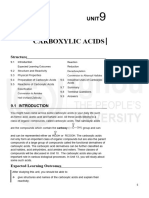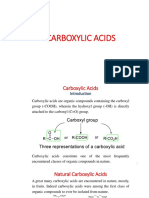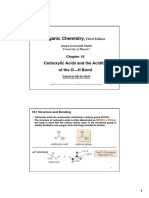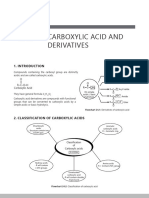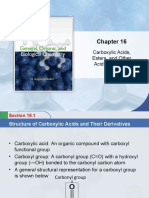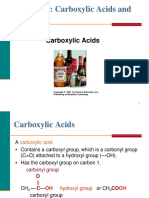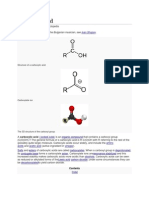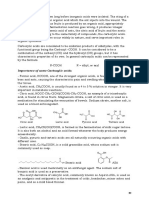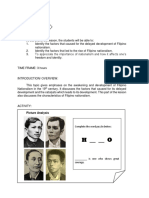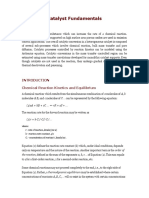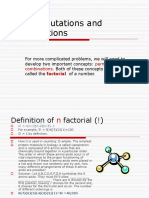Professional Documents
Culture Documents
Carboxylic Acid - Wikipedia
Uploaded by
Badhon Chandra SarkarOriginal Title
Copyright
Available Formats
Share this document
Did you find this document useful?
Is this content inappropriate?
Report this DocumentCopyright:
Available Formats
Carboxylic Acid - Wikipedia
Uploaded by
Badhon Chandra SarkarCopyright:
Available Formats
Search Wikipedia Search Create account Log in
Carboxylic acid 78 languages
Contents hide Article Talk Read Edit View history Tools
(Top) From Wikipedia, the free encyclopedia
Examples and nomenclature (Redirected from Carboxyl)
Physical properties
"COOH" redirects here. For the Bulgarian musician, see Ivan Shopov.
Solubility Not to be confused with Carbolic acid.
Boiling points In organic chemistry, a carboxylic acid is an organic acid that contains a carboxyl group (−C(=O)−OH)[1] attached to an
Acidity R-group. The general formula of a carboxylic acid is often written as R−COOH or R−CO2H, sometimes as R−C(O)OH with
R referring to the alkyl, alkenyl, aryl, or other group. Carboxylic acids occur widely. Important examples include the amino
Odour
acids and fatty acids. Deprotonation of a carboxylic acid gives a carboxylate anion.
Characterization
Occurrence and applications Examples and nomenclature [ edit ]
Structure of a
Synthesis
Carboxylic acids are commonly identified by their trivial names. They often have the suffix -ic acid. IUPAC-recommended carboxylic acid
Industrial routes names also exist; in this system, carboxylic acids have an -oic acid suffix.[2] For example, butyric acid (CH3CH2CH2CO2H)
Laboratory methods is butanoic acid by IUPAC guidelines. For nomenclature of complex molecules containing a carboxylic acid, the carboxyl can
be considered position one of the parent chain even if there are other substituents, such as 3-chloropropanoic acid.
Less-common reactions
Alternately, it can be named as a "carboxy" or "carboxylic acid" substituent on another parent structure, such as 2-
Reactions carboxyfuran.
Reduction − −
The carboxylate anion (R−COO or R−CO2) of a carboxylic acid is usually named with the suffix -ate, in keeping with the
Specialized reactions general pattern of -ic acid and -ate for a conjugate acid and its conjugate base, respectively. For example, the conjugate
Carboxyl radical base of acetic acid is acetate. Carboxylate anion
See also
Carbonic acid, which occurs in bicarbonate buffer systems in nature, is not generally classed as one of the carboxylic acids,
References despite that it has a moiety that looks like a COOH group.
External links
Straight-chain, saturated carboxylic acids (alkanoic acids)
Carbon Common Chemical
IUPAC Name Common location or use
atoms Name formula
1 Formic acid Methanoic acid HCOOH Insect stings
2 Acetic acid Ethanoic acid CH3COOH Vinegar 3D structure of
a carboxylic acid
Preservative for stored grains, body
3 Propionic acid Propanoic acid CH3CH2COOH
odour, milk, butter, cheese
Wikiquote has quotations
4 Butyric acid Butanoic acid CH3(CH2)2COOH Butter related to Carboxylic acid.
5 Valeric acid Pentanoic acid CH3(CH2)3COOH Valerian plant
6 Caproic acid Hexanoic acid CH3(CH2)4COOH Goat fat
7 Enanthic acid Heptanoic acid CH3(CH2)5COOH Fragrance
8 Caprylic acid Octanoic acid CH3(CH2)6COOH Coconuts
9 Pelargonic acid Nonanoic acid CH3(CH2)7COOH Pelargonium plant
10 Capric acid Decanoic acid CH3(CH2)8COOH Coconut and Palm kernel oil
11 Undecylic acid Undecanoic acid CH3(CH2)9COOH Anti-fungal agent
12 Lauric acid Dodecanoic acid CH3(CH2)10COOH Coconut oil and hand wash soaps
13 Tridecylic acid Tridecanoic acid CH3(CH2)11COOH Plant metabolite
Tetradecanoic
14 Myristic acid CH3(CH2)12COOH Nutmeg
acid
Pentadecylic Pentadecanoic
15 CH3(CH2)13COOH Milk fat
acid acid
Hexadecanoic
16 Palmitic acid CH3(CH2)14COOH Palm oil
acid
Heptadecanoic
17 Margaric acid CH3(CH2)15COOH Pheromone in various animals
acid
Octadecanoic
18 Stearic acid CH3(CH2)16COOH Chocolate, waxes, soaps, and oils
acid
Nonadecylic Nonadecanoic
19 CH3(CH2)17COOH Fats, vegetable oils, pheromone
acid acid
20 Arachidic acid Icosanoic acid CH3(CH2)18COOH Peanut oil
Other carboxylic acids
Compound class Members
unsaturated
acrylic acid (2-propenoic acid) – CH2=CH−COOH, used in polymer synthesis
monocarboxylic acids
medium to long-chain saturated and unsaturated monocarboxylic acids, with even number of carbons; examples:
Fatty acids
docosahexaenoic acid and eicosapentaenoic acid (nutritional supplements)
Amino acids the building-blocks of proteins
Keto acids acids of biochemical significance that contain a ketone group; examples: acetoacetic acid and pyruvic acid
containing at least one aromatic ring; examples: benzoic acid – the sodium salt of benzoic acid is used as a food preservative;
Aromatic carboxylic
salicylic acid – a beta-hydroxy type found in many skin-care products; phenyl alkanoic acids – the class of compounds where
acids
a phenyl group is attached to a carboxylic acid
containing two carboxyl groups; examples: adipic acid the monomer used to produce nylon and aldaric acid – a family of
Dicarboxylic acids
sugar acids
Tricarboxylic acids containing three carboxyl groups; examples: citric acid – found in citrus fruits and isocitric acid
containing a hydroxy group in the first position; examples: glyceric acid, glycolic acid and lactic acid (2-hydroxypropanoic acid)
Alpha hydroxy acids
– found in sour milk, tartaric acid – found in wine
Beta hydroxy acids containing a hydroxy group in the second position
Omega hydroxy acids containing a hydroxy group beyond the first or second position
Divinylether fatty acids containing a doubly unsaturated carbon chain attached via an ether bond to a fatty acid, found in some plants
Physical properties [ edit ]
Solubility [ edit ]
Carboxylic acids are polar. Because they are both hydrogen-bond acceptors (the carbonyl −C(=O)−) and hydrogen-bond donors (the hydroxyl −OH), they
also participate in hydrogen bonding. Together, the hydroxyl and carbonyl group form the functional group carboxyl. Carboxylic acids usually exist as
dimers in nonpolar media due to their tendency to "self-associate". Smaller carboxylic acids (1 to 5 carbons) are soluble in water, whereas bigger
carboxylic acids have limited solubility due to the increasing hydrophobic nature of the alkyl chain. These longer chain acids tend to be soluble in less-
polar solvents such as ethers and alcohols.[3] Aqueous sodium hydroxide and carboxylic acids, even hydrophobic ones, react to yield water-soluble
sodium salts. For example, enanthic acid has a low solubility in water (0.2 g/L), but its sodium salt is very soluble in water.
Boiling points [ edit ]
Carboxylic acids tend to have higher boiling points than water, because of their greater surface areas and their tendency to form stabilized dimers
through hydrogen bonds. For boiling to occur, either the dimer bonds must be broken or the entire dimer arrangement must be vaporized, increasing the
enthalpy of vaporization requirements significantly.
Carboxylic acid dimers
Acidity [ edit ]
Carboxylic acids are Brønsted–Lowry acids because they are proton (H+) donors. They are the most common type of organic acid.
+ −
Carboxylic acids are typically weak acids, meaning that they only partially dissociate into [H3O] cations and R−CO2 anions in neutral aqueous solution.
For example, at room temperature, in a 1-molar solution of acetic acid, only 0.001% of the acid are dissociated (i.e. 10−5 moles out of 1 mol). Electron-
withdrawing substituents, such as -CF3 group, give stronger acids (the pKa of acetic acid is 4.76 whereas trifluoroacetic acid, with a trifluoromethyl
substituent, has a pKa of 0.23). Electron-donating substituents give weaker acids (the pKa of formic acid is 3.75 whereas acetic acid, with a methyl
substituent, has a pKa of 4.76)
Carboxylic acid[4] pKa
Formic acid (HCO2H) 3.75
Chloroformic acid (ClCO2H) 0.27[5]
Acetic acid (CH3CO2H) 4.76
Glycine (NH2CH2CO2H) 2.34
Fluoroacetic acid (FCH2CO2H) 2.586
Difluoroacetic acid (F2CHCO2H) 1.33
Trifluoroacetic acid (CF3CO2H) 0.23
Chloroacetic acid (ClCH2CO2H) 2.86
Dichloroacetic acid (Cl2CHCO2H) 1.29
Trichloroacetic acid (CCl3CO2H) 0.65
Benzoic acid (C6H5−CO2H) 4.2
2-Nitrobenzoic acid (ortho-C6H4(NO2)CO2H) 2.16
Oxalic acid (HO−C(=O)−C(=O)−OH) (first dissociation) 1.27
−
Hydrogen oxalate (HO−C(=O)−CO2) (second dissociation of oxalic acid) 4.14
Deprotonation of carboxylic acids gives carboxylate anions; these are resonance stabilized, because the negative charge is delocalized over the two
oxygen atoms, increasing the stability of the anion. Each of the carbon–oxygen bonds in the carboxylate anion has a partial double-bond character. The
carbonyl carbon's partial positive charge is also weakened by the -1/2 negative charges on the 2 oxygen atoms.
Odour [ edit ]
Carboxylic acids often have strong sour odours. Esters of carboxylic acids tend to have fruity, pleasant odours, and many are used in perfume.
Characterization [ edit ]
Carboxylic acids are readily identified as such by infrared spectroscopy. They exhibit a sharp band associated with vibration of the C=O carbonyl bond
(νC=O) between 1680 and 1725 cm−1. A characteristic νO–H band appears as a broad peak in the 2500 to 3000 cm−1 region.[3][6] By 1H NMR
spectrometry, the hydroxyl hydrogen appears in the 10–13 ppm region, although it is often either broadened or not observed owing to exchange with
traces of water.
Occurrence and applications [ edit ]
Many carboxylic acids are produced industrially on a large scale. They are also frequently found in nature. Esters of fatty acids are the main components
of lipids and polyamides of aminocarboxylic acids are the main components of proteins.
Carboxylic acids are used in the production of polymers, pharmaceuticals, solvents, and food additives. Industrially important carboxylic acids include
acetic acid (component of vinegar, precursor to solvents and coatings), acrylic and methacrylic acids (precursors to polymers, adhesives), adipic acid
(polymers), citric acid (a flavor and preservative in food and beverages), ethylenediaminetetraacetic acid (chelating agent), fatty acids (coatings), maleic
acid (polymers), propionic acid (food preservative), terephthalic acid (polymers). Important carboxylate salts are soaps.
Synthesis [ edit ]
Industrial routes [ edit ]
In general, industrial routes to carboxylic acids differ from those used on a smaller scale because they require specialized equipment.
Carbonylation of alcohols as illustrated by the Cativa process for the production of acetic acid. Formic acid is prepared by a different carbonylation
pathway, also starting from methanol.
Oxidation of aldehydes with air using cobalt and manganese catalysts. The required aldehydes are readily obtained from alkenes by
hydroformylation.
Oxidation of hydrocarbons using air. For simple alkanes, this method is inexpensive but not selective enough to be useful. Allylic and benzylic
compounds undergo more selective oxidations. Alkyl groups on a benzene ring are oxidized to the carboxylic acid, regardless of its chain length.
Benzoic acid from toluene, terephthalic acid from para-xylene, and phthalic acid from ortho-xylene are illustrative large-scale conversions. Acrylic acid
is generated from propene.[7]
Oxidation of ethene using silicotungstic acid catalyst.
Base-catalyzed dehydrogenation of alcohols.
Carbonylation coupled to the addition of water. This method is effective and versatile for alkenes that generate secondary and tertiary carbocations,
e.g. isobutylene to pivalic acid. In the Koch reaction, the addition of water and carbon monoxide to alkenes or alkynes is catalyzed by strong acids.
Hydrocarboxylations involve the simultaneous addition of water and CO. Such reactions are sometimes called "Reppe chemistry."
HC≡CH + CO + H2O → CH2=CH−CO2H
Hydrolysis of triglycerides obtained from plant or animal oils. These methods of synthesizing some long-chain carboxylic acids are related to soap
making.
Fermentation of ethanol. This method is used in the production of vinegar.
The Kolbe–Schmitt reaction provides a route to salicylic acid, precursor to aspirin.
Laboratory methods [ edit ]
Preparative methods for small scale reactions for research or for production of fine chemicals often employ expensive consumable reagents.
Oxidation of primary alcohols or aldehydes with strong oxidants such as potassium dichromate, Jones reagent, potassium permanganate, or sodium
chlorite. The method is more suitable for laboratory conditions than the industrial use of air, which is "greener" because it yields less inorganic side
products such as chromium or manganese oxides.[citation needed]
Oxidative cleavage of olefins by ozonolysis, potassium permanganate, or potassium dichromate.
Hydrolysis of nitriles, esters, or amides, usually with acid- or base-catalysis.
Carbonation of a Grignard reagent and organolithium reagents:
− +
RLi + CO2 → RCO2Li
− +
RCO2Li + HCl → RCO2H + LiCl
Halogenation followed by hydrolysis of methyl ketones in the haloform reaction
Base-catalyzed cleavage of non-enolizable ketones, especially aryl ketones:[8]
R−C(=O)−Ar + H2O → R−CO2H + ArH
Less-common reactions [ edit ]
Many reactions produce carboxylic acids but are used only in specific cases or are mainly of academic interest.
Disproportionation of an aldehyde in the Cannizzaro reaction
Rearrangement of diketones in the benzilic acid rearrangement
Involving the generation of benzoic acids are the von Richter reaction from nitrobenzenes and the Kolbe–Schmitt reaction from phenols.
Reactions [ edit ]
The most widely practiced reactions convert carboxylic acids into esters, amides,
carboxylate salts, acid chlorides, and alcohols. Carboxylic acids react with bases to
form carboxylate salts, in which the hydrogen of the hydroxyl (–OH) group is
replaced with a metal cation. For example, acetic acid found in vinegar reacts with
sodium bicarbonate (baking soda) to form sodium acetate, carbon dioxide, and
water:
− +
CH3COOH + NaHCO3 → CH3COO Na + CO2 + H2O
Carboxylic acids also react with alcohols to give esters. This process is widely
used, e.g. in the production of polyesters. Likewise, carboxylic acids are converted
into amides, but this conversion typically does not occur by direct reaction of the
carboxylic acid and the amine. Instead esters are typical precursors to amides. The
conversion of amino acids into peptides is a significant biochemical process that Carboxylic acid organic reactions
requires ATP.
The hydroxyl group on carboxylic acids may be replaced with a chlorine atom using thionyl chloride to give acyl chlorides. In nature, carboxylic acids are
converted to thioesters.
Reduction [ edit ]
Like esters, most carboxylic acids can be reduced to alcohols by hydrogenation, or using hydride transferring agents such as lithium aluminium hydride.
Strong alkyl transferring agents, such as organolithium compounds but not Grignard reagents, will reduce carboxylic acids to ketones along with transfer
of the alkyl group.
Vilsmaier reagent (N,N-Dimethyl(chloromethylene)ammonium chloride [ClHC\dN+(CH3)2]Cl−) is a highly chemoselective agent for carboxylic acid
reduction. It selectively activates the carboxylic acid to give the carboxymethyleneammonium salt, which can be reduced by a mild reductant like lithium
tris(t-butoxy)aluminum hydride to afford an aldehyde in a one pot procedure. This procedure is known to tolerate reactive carbonyl functionalities such as
ketone as well as moderately reactive ester, olefin, nitrile, and halide moieties.[9]
Specialized reactions [ edit ]
As with all carbonyl compounds, the protons on the α-carbon are labile due to keto–enol tautomerization. Thus, the α-carbon is easily halogenated in
the Hell–Volhard–Zelinsky halogenation.
The Schmidt reaction converts carboxylic acids to amines.
Carboxylic acids are decarboxylated in the Hunsdiecker reaction.
The Dakin–West reaction converts an amino acid to the corresponding amino ketone.
In the Barbier–Wieland degradation, a carboxylic acid on an aliphatic chain having a simple methylene bridge at the alpha position can have the
chain shortened by one carbon. The inverse procedure is the Arndt–Eistert synthesis, where an acid is converted into acyl halide, which is then
reacted with diazomethane to give one additional methylene in the aliphatic chain.
Many acids undergo oxidative decarboxylation. Enzymes that catalyze these reactions are known as carboxylases (EC 6.4.1) and decarboxylases
(EC 4.1.1).
Carboxylic acids are reduced to aldehydes via the ester and DIBAL, via the acid chloride in the Rosenmund reduction and via the thioester in the
Fukuyama reduction.
In ketonic decarboxylation carboxylic acids are converted to ketones.
Organolithium reagents (>2 equiv) react with carboxylic acids to give a dilithium 1,1-diolate, a stable tetrahedral intermediate which decomposes to
give a ketone upon acidic workup.
The Kolbe electrolysis is an electrolytic, decarboxylative dimerization reaction. It gets rid of the carboxyl groups of two acid molecules, and joins the
remaining fragments together.
Carboxyl radical [ edit ]
The carboxyl radical, •COOH, only exists briefly.[10] The acid dissociation constant of •COOH has been measured using electron paramagnetic
resonance spectroscopy.[11] The carboxyl group tends to dimerise to form oxalic acid.
See also [ edit ]
Acid anhydride
Acid chloride
Amide
Amino acid
Ester
List of carboxylic acids
Dicarboxylic acid
Pseudoacid
Thiocarboxy
Carbon dioxide (CO2)
References [ edit ]
1. ^ IUPAC, Compendium of Chemical Terminology, 2nd ed. (the "Gold Book") 8. ^ Perry C. Reeves (1977). "Carboxylation of Aromatic Compounds:
(1997). Online corrected version: (2006–) "carboxylic acids ". Ferrocenecarboxylic Acid". Org. Synth. 56: 28.
doi:10.1351/goldbook.C00852 doi:10.15227/orgsyn.056.0028 .
2. ^ Recommendations 1979 . Organic Chemistry IUPAC Nomenclature. 9. ^ Fujisawa, Tamotsu; Sato, Toshio. "Reduction of carboxylic acids to
Rules C-4 Carboxylic Acids and Their Derivatives. aldehydes: 6-Ooxdecanal" . Organic Syntheses. 66: 121.
3. ^ a b Morrison, R.T.; Boyd, R.N. (1992). Organic Chemistry (6th ed.). doi:10.15227/orgsyn.066.0121 .; Collective Volume, vol. 8, p. 498
Prentice Hall. ISBN 0-13-643669-2. 10. ^ Milligan, D. E.; Jacox, M. E. (1971). "Infrared Spectrum and Structure of
4. ^ Haynes, William M., ed. (2011). CRC Handbook of Chemistry and Physics Intermediates in Reaction of OH with CO". Journal of Chemical Physics. 54
(92nd ed.). CRC Press. pp. 5–94 to 5–98. ISBN 978-1439855119. (3): 927–942. Bibcode:1971JChPh..54..927M . doi:10.1063/1.1675022 .
5. ^ "Chlorocarbonic acid" . Human Metabolome Database. 11. ^ The value is pKa = −0.2 ± 0.1. Jeevarajan, A. S.; Carmichael, I.;
6. ^ Smith, Brian. "The C=O Bond, Part VIII: Review" . Spectroscopy. Fessenden, R. W. (1990). "ESR Measurement of the pKa of Carboxyl
Retrieved 12 February 2024. Radical and Ab Initio Calculation of the Carbon-13 Hyperfine Constant".
7. ^ Riemenschneider, Wilhelm (2002). "Carboxylic Acids, Aliphatic". Ullmann's Journal of Physical Chemistry. 94 (4): 1372–1376.
Encyclopedia of Industrial Chemistry. Weinheim: Wiley-VCH. doi:10.1021/j100367a033 .
doi:10.1002/14356007.a05_235 . ISBN 3527306730..
External links [ edit ]
Carboxylic acids pH and titration – freeware for calculations, data analysis, simulation, and distribution Look up carboxyl in
diagram generation Wiktionary, the free
dictionary.
PHC.
· · Functional groups [show]
· · Topics in organic reactions [show]
Authority control databases: National Germany · Israel · United States · Japan · Czech Republic
Categories: Carboxylic acids Functional groups
This page was last edited on 12 February 2024, at 23:07 (UTC).
Text is available under the Creative Commons Attribution-ShareAlike License 4.0; additional terms may apply. By using this site, you agree to the Terms of Use and Privacy Policy. Wikipedia® is a registered trademark of the Wikimedia Foundation, Inc., a non-profit
organization.
Privacy policy About Wikipedia Disclaimers Contact Wikipedia Code of Conduct Developers Statistics Cookie statement Mobile view
You might also like
- Lecture 5 Carboxylic Acids and Esters-2Document113 pagesLecture 5 Carboxylic Acids and Esters-2JowayriyyahNo ratings yet
- Aliphatic Compounds: Trihydric Alcohols, Their Oxidation Products and Derivatives, Penta- and Higher Polyhydric Alcohols, Their Oxidation Products and Derivatives; Saccharides, Tetrahydric Alcohols, Their Oxidation Products and DerivativesFrom EverandAliphatic Compounds: Trihydric Alcohols, Their Oxidation Products and Derivatives, Penta- and Higher Polyhydric Alcohols, Their Oxidation Products and Derivatives; Saccharides, Tetrahydric Alcohols, Their Oxidation Products and DerivativesNo ratings yet
- Carboxylic AcidsDocument45 pagesCarboxylic AcidsVann BanastaoNo ratings yet
- Block 3Document100 pagesBlock 3KeshavRaviNo ratings yet
- SCH 206-Carboxylic Acids PDFDocument48 pagesSCH 206-Carboxylic Acids PDFShivani DamorNo ratings yet
- SCH 206-Carboxylic Acids PDFDocument48 pagesSCH 206-Carboxylic Acids PDFCon Amor Para TlaxcalaNo ratings yet
- Modern Minimalist Black and White Report PresentationDocument72 pagesModern Minimalist Black and White Report PresentationPRINCESS NOELLEE TRAYVILLANo ratings yet
- Unit 6Document5 pagesUnit 6Abu ManNo ratings yet
- Carboxylic Acids: Animaton 13.1: Addition of HCL To A Carbonyl Group Source & Credit: CH - ImperialDocument14 pagesCarboxylic Acids: Animaton 13.1: Addition of HCL To A Carbonyl Group Source & Credit: CH - ImperialAxad Ali ChaudharyNo ratings yet
- Chemistry: Tests For Carboxylic GroupDocument2 pagesChemistry: Tests For Carboxylic GroupMesfen MeleseNo ratings yet
- Chapter 21-25 PDFDocument134 pagesChapter 21-25 PDFHimanshu RanjanNo ratings yet
- 10.0 Carboxylic Acids 2021Document64 pages10.0 Carboxylic Acids 2021NURUL HIDAYAH SAIFUL ANUARNo ratings yet
- Chapter 10 Notes: Carboxylic Acids, Amines, and AmidesDocument20 pagesChapter 10 Notes: Carboxylic Acids, Amines, and AmidesABHISHEK MISHRANo ratings yet
- Carboxylic AcidDocument21 pagesCarboxylic Acidelizabeth merzyNo ratings yet
- ChemistryDocument6 pagesChemistryGrishma ChokshiNo ratings yet
- Chapter 05 2SPPDocument42 pagesChapter 05 2SPPAbdur RehmanNo ratings yet
- Carboxylic Acid Naming and PropertiesDocument1 pageCarboxylic Acid Naming and PropertiesPaula CaborubiasNo ratings yet
- Ácidos Carboxilicos PresentaciónDocument117 pagesÁcidos Carboxilicos PresentaciónCindy RamirezNo ratings yet
- Organic Chemistry,: Carboxylic Acids and The Acidity of The O-H BondDocument26 pagesOrganic Chemistry,: Carboxylic Acids and The Acidity of The O-H Bondsungyeon heoNo ratings yet
- Aldehydes, Ketones and Carboxylic Acids: Module - 7Document29 pagesAldehydes, Ketones and Carboxylic Acids: Module - 7TeachingTrainingCoaching KnowledgeSharingSessionNo ratings yet
- Notes C16 121Document13 pagesNotes C16 121Amir HussainNo ratings yet
- Carboxylic Acids and Carboxylic Acid Derivatives: Himilo University Course Name: Organic ChemistryDocument37 pagesCarboxylic Acids and Carboxylic Acid Derivatives: Himilo University Course Name: Organic ChemistryAbdulkarim FagaaseNo ratings yet
- CARBOXYLIC ACIDS: KEY PROPERTIESDocument7 pagesCARBOXYLIC ACIDS: KEY PROPERTIESAntonia GhitaNo ratings yet
- Organic CH Emistry Ii CHM301: Carboxylic AcidsDocument53 pagesOrganic CH Emistry Ii CHM301: Carboxylic AcidsWAN NUR AISYAH WAN AZIZANNo ratings yet
- Catboxylic Acids and Their DerivativesDocument45 pagesCatboxylic Acids and Their DerivativesAnil Kumar VermaNo ratings yet
- LG 1.3 Nomenclature of Organic CompoundsDocument11 pagesLG 1.3 Nomenclature of Organic CompoundswangmorisNo ratings yet
- Car Boxy LicDocument29 pagesCar Boxy Licaditya.sachanNo ratings yet
- Chem 1115 Acids and Esters Ch.17Document17 pagesChem 1115 Acids and Esters Ch.17Roby PadillaNo ratings yet
- 7-10.4carboxylic Acids and EstersDocument10 pages7-10.4carboxylic Acids and EsterstakomolyentinNo ratings yet
- Chapter 1 - CARBOXYLIC ACID AND CARBOXYLIC ACID DERIVATIVESDocument110 pagesChapter 1 - CARBOXYLIC ACID AND CARBOXYLIC ACID DERIVATIVESVy NguyễnNo ratings yet
- Kyiv University Carboxylic Acids GuideDocument38 pagesKyiv University Carboxylic Acids GuideDharmveer SharmaNo ratings yet
- PDF Carboxylic AcidsDocument45 pagesPDF Carboxylic AcidsRegina Maree BermudezNo ratings yet
- Carboxylic Acid 2Document20 pagesCarboxylic Acid 2brettNo ratings yet
- Alok Sr. Sec. School: Hiran Magri, Sector-11 Udaipur Session 2019-2020Document17 pagesAlok Sr. Sec. School: Hiran Magri, Sector-11 Udaipur Session 2019-2020Shivani Damor100% (1)
- Edited PPT On Carboxylic AcidDocument51 pagesEdited PPT On Carboxylic AcidRenante DavisNo ratings yet
- Introduction To Organic ChemistryDocument31 pagesIntroduction To Organic Chemistryauni ramizahNo ratings yet
- by NVS TEACHER Aldehydes Ketones and Acids Part 3Document35 pagesby NVS TEACHER Aldehydes Ketones and Acids Part 3Srushti GorasiyaNo ratings yet
- Carboxylic Acids, Anhydrides, Esters, and AmidesDocument35 pagesCarboxylic Acids, Anhydrides, Esters, and AmidesHarshwardhan PhatakNo ratings yet
- 01 - Biochemistry & Biomolecules PDFDocument25 pages01 - Biochemistry & Biomolecules PDFNURDAYANA NADHIRAH HAFIZANo ratings yet
- LayoutDocument55 pagesLayoutHenok Moges KassahunNo ratings yet
- Chapter 14 Carboxylic Ester Amides PDFDocument22 pagesChapter 14 Carboxylic Ester Amides PDFMADANNo ratings yet
- SAM Organic Chemistry Carboxylic AcidsDocument8 pagesSAM Organic Chemistry Carboxylic AcidsChangWeiTanNo ratings yet
- 5 Stoker Carboxylic Acids & DerivativesDocument37 pages5 Stoker Carboxylic Acids & DerivativesGURPARABJOT KAURNo ratings yet
- Reactions of Carboxylic Acids and Its DerivativesDocument40 pagesReactions of Carboxylic Acids and Its DerivativesRoger ReyesNo ratings yet
- Asam Karboksilat Dan EsterDocument42 pagesAsam Karboksilat Dan EsterayiNo ratings yet
- Unit 15A: Carboxylic AcidsDocument21 pagesUnit 15A: Carboxylic AcidsKazel Lyca SarmientoNo ratings yet
- Carboxylic Acid: Classification: Based On The Number of COOH GroupsDocument7 pagesCarboxylic Acid: Classification: Based On The Number of COOH Groupsvandv printsNo ratings yet
- Chapter 4 Carboxylic Acids 1Document69 pagesChapter 4 Carboxylic Acids 1VALERIA FERNANDA MEDINA LAGOSNo ratings yet
- Carboxylic Acid: "COOH" Redirects Here. For The Bulgarian Musician, SeeDocument9 pagesCarboxylic Acid: "COOH" Redirects Here. For The Bulgarian Musician, SeeFighter_ace_97No ratings yet
- Nomenclature of Carboxylic Acids and Its DerivativesDocument7 pagesNomenclature of Carboxylic Acids and Its DerivativesAda VessaliusNo ratings yet
- Carboxylic Acid and EstersDocument49 pagesCarboxylic Acid and EstersJEAN I MAGLAQUENo ratings yet
- Notes VIaDocument2 pagesNotes VIaAmahNo ratings yet
- Carboxylic AcidsDocument98 pagesCarboxylic Acidsrouben09castroNo ratings yet
- Introduction To Naming and Drawing of Carboxylic Acids and EsterDocument38 pagesIntroduction To Naming and Drawing of Carboxylic Acids and Esterkartika.pranotoNo ratings yet
- Carboxylic Acids and Derivatives ExplainedDocument12 pagesCarboxylic Acids and Derivatives ExplainedÏt's RîçkgãrçīäNo ratings yet
- Hydroxy and Keto AcidsDocument14 pagesHydroxy and Keto AcidsSarah FathimaNo ratings yet
- DAY 6 Carboxylic Acids For MCATDocument50 pagesDAY 6 Carboxylic Acids For MCATIan HoffmanNo ratings yet
- AVCL 9A Properties of Carboxylic Acids and EstersDocument8 pagesAVCL 9A Properties of Carboxylic Acids and EstersGiane MadrigalNo ratings yet
- Carboxylic Acids and Their DerivativesDocument22 pagesCarboxylic Acids and Their DerivativesEugene OkpanteyNo ratings yet
- Abortion Is (Again) A Criminal-Justice Issue - The Texas ObserverDocument1 pageAbortion Is (Again) A Criminal-Justice Issue - The Texas ObserverBadhon Chandra SarkarNo ratings yet
- 16th Amendment Judgement PDF - Google SearchDocument1 page16th Amendment Judgement PDF - Google SearchBadhon Chandra SarkarNo ratings yet
- Unnatural Offences - Decrypting The Phrase, Against The Order of Nature'Document1 pageUnnatural Offences - Decrypting The Phrase, Against The Order of Nature'Badhon Chandra SarkarNo ratings yet
- Age-Old Law Restricts Women's Right To Abortion in BangladeshDocument1 pageAge-Old Law Restricts Women's Right To Abortion in BangladeshBadhon Chandra SarkarNo ratings yet
- Cricket Scorecard - India Vs England, 2nd Test, England Tour of India, 2024Document1 pageCricket Scorecard - India Vs England, 2nd Test, England Tour of India, 2024Badhon Chandra SarkarNo ratings yet
- What Is Putrefaction - Process of Putrefaction and Factors Affecting ItDocument1 pageWhat Is Putrefaction - Process of Putrefaction and Factors Affecting ItBadhon Chandra SarkarNo ratings yet
- CMCH Morgue Guard Arrested On Charge of NecrophiliaDocument1 pageCMCH Morgue Guard Arrested On Charge of NecrophiliaBadhon Chandra SarkarNo ratings yet
- Women's Health - Macquarie-St-ClinicDocument1 pageWomen's Health - Macquarie-St-ClinicBadhon Chandra SarkarNo ratings yet
- What Is Necrophilia - Mental Illness Where Individual Find Pleasure in Having Physical Relation With Dead BodiesDocument1 pageWhat Is Necrophilia - Mental Illness Where Individual Find Pleasure in Having Physical Relation With Dead BodiesBadhon Chandra SarkarNo ratings yet
- Category - Murder in India - WikipediaDocument1 pageCategory - Murder in India - WikipediaBadhon Chandra SarkarNo ratings yet
- What Is Harassment and What Is Not - Google SearchDocument1 pageWhat Is Harassment and What Is Not - Google SearchBadhon Chandra SarkarNo ratings yet
- When Someone Dies in JapanDocument1 pageWhen Someone Dies in JapanBadhon Chandra SarkarNo ratings yet
- 2009 Shopian Rape and Murder Case - WikipediaDocument1 page2009 Shopian Rape and Murder Case - WikipediaBadhon Chandra SarkarNo ratings yet
- Why Mumbai Indians Took Away Captaincy From Rohit SharmaDocument1 pageWhy Mumbai Indians Took Away Captaincy From Rohit SharmaBadhon Chandra SarkarNo ratings yet
- Elanthoor Human Sacrifice Case - WikipediaDocument1 pageElanthoor Human Sacrifice Case - Wikipediabaponcsarkar2004No ratings yet
- Crime in India - WikipediaDocument1 pageCrime in India - WikipediaBadhon Chandra SarkarNo ratings yet
- Hanskhali Rape Case - WikipediaDocument1 pageHanskhali Rape Case - WikipediaBadhon Chandra SarkarNo ratings yet
- Hazard - WikipediaDocument1 pageHazard - WikipediaBadhon Chandra SarkarNo ratings yet
- All About The Hathras Case - IpleadersDocument1 pageAll About The Hathras Case - IpleadersBadhon Chandra SarkarNo ratings yet
- 1990 Bantala Rape Case - WikipediaDocument1 page1990 Bantala Rape Case - Wikipediabaponcsarkar2004No ratings yet
- Anand Marrige Act, 1909Document3 pagesAnand Marrige Act, 1909Abhey JindalNo ratings yet
- Multicellular Organism - WikipediaDocument1 pageMulticellular Organism - WikipediaBadhon Chandra SarkarNo ratings yet
- Act 5 April 1998Document21 pagesAct 5 April 1998Badhon Chandra SarkarNo ratings yet
- Horse-Drawn Vehicle - WikipediaDocument1 pageHorse-Drawn Vehicle - WikipediaBadhon Chandra SarkarNo ratings yet
- Animal - WikipediaDocument1 pageAnimal - WikipediaBadhon Chandra SarkarNo ratings yet
- History - WikipediaDocument1 pageHistory - WikipediaBadhon Chandra SarkarNo ratings yet
- Means of Transport - WikipediaDocument1 pageMeans of Transport - WikipediaBadhon Chandra SarkarNo ratings yet
- Lactic Acid - WikipediaDocument1 pageLactic Acid - WikipediaBadhon Chandra SarkarNo ratings yet
- Trier of Fact - WikipediaDocument1 pageTrier of Fact - WikipediaBadhon Chandra SarkarNo ratings yet
- Neolithic Farming Villages Jericho and Catal HuyukDocument1 pageNeolithic Farming Villages Jericho and Catal HuyukPream BoleoNo ratings yet
- Remote Control Panel (RCP) User'S GuideDocument13 pagesRemote Control Panel (RCP) User'S GuideAdrian PuscasNo ratings yet
- Filipino Nationalism LessonDocument24 pagesFilipino Nationalism LessonIan Jay TumulakNo ratings yet
- SD Series Digital AC Servo System User Manual GuideDocument66 pagesSD Series Digital AC Servo System User Manual GuideAdnene SaanounNo ratings yet
- Study Note 1 Fundamental of AccountingDocument54 pagesStudy Note 1 Fundamental of Accountingnaga naveenNo ratings yet
- Binh Dien Fertilizer Joint Stock CompanyDocument11 pagesBinh Dien Fertilizer Joint Stock CompanyHuynh Minh Quan B2014431No ratings yet
- Assignments - 2017 09 15 182103 - PDFDocument49 pagesAssignments - 2017 09 15 182103 - PDFMena AlzahawyNo ratings yet
- 1 Catalyst FundamentalsDocument17 pages1 Catalyst FundamentalsSam AnuNo ratings yet
- How To VOR WorksDocument23 pagesHow To VOR WorksHai AuNo ratings yet
- Re15209 03-95Document8 pagesRe15209 03-95Kaushik GhoshNo ratings yet
- Critical Buckling Load of Pile in Liquefied SoilDocument8 pagesCritical Buckling Load of Pile in Liquefied SoilKefas JanuarNo ratings yet
- Timetable 1Document1 pageTimetable 1sunilbijlaniNo ratings yet
- Mutual FundDocument2 pagesMutual Fundkum_praNo ratings yet
- Semiconductor Optical AmplifierDocument40 pagesSemiconductor Optical AmplifierVikas ThakurNo ratings yet
- What is phonicsDocument244 pagesWhat is phonicsNelly FernandezNo ratings yet
- Accounting Project Topics and Materials in NigeriaDocument97 pagesAccounting Project Topics and Materials in NigeriaProject Championz100% (2)
- S-H Polarimeter Polartronic-532 Eng - 062015 PDFDocument2 pagesS-H Polarimeter Polartronic-532 Eng - 062015 PDFSuresh KumarNo ratings yet
- Segmentation: NIVEA Sun Case Study Summary Downloaded From The Times 100 Edition 11Document2 pagesSegmentation: NIVEA Sun Case Study Summary Downloaded From The Times 100 Edition 11Boon-Pin NgNo ratings yet
- Four Pillars of EducationDocument42 pagesFour Pillars of EducationWinter BacalsoNo ratings yet
- Modigliani MillerDocument12 pagesModigliani MillerAlvaro CamañoNo ratings yet
- Master in Public Management: Application PacketDocument6 pagesMaster in Public Management: Application PacketMark GironNo ratings yet
- Basic Electronic ComponentsDocument28 pagesBasic Electronic ComponentsJafar ShaikhNo ratings yet
- 02.casebook - BLDG Repairs & Maint - Chapter 1 - 2011 (Water Seepage)Document13 pages02.casebook - BLDG Repairs & Maint - Chapter 1 - 2011 (Water Seepage)Hang kong TseNo ratings yet
- 6.4 Permutations and CombinationsDocument14 pages6.4 Permutations and CombinationsAns SembiringNo ratings yet
- HL-1060 User, Parts, and Service Manual 02Document6 pagesHL-1060 User, Parts, and Service Manual 02วรพงษ์ กอชัชวาลNo ratings yet
- Oral Communication Skills Assessment Republic of the PhilippinesDocument3 pagesOral Communication Skills Assessment Republic of the PhilippinesMarissa UrnosNo ratings yet
- PW 160-Taliban Fragmentation Fact Fiction and Future-PwDocument28 pagesPW 160-Taliban Fragmentation Fact Fiction and Future-Pwrickyricardo1922No ratings yet
- SAQ Ans 6Document3 pagesSAQ Ans 6harshanauocNo ratings yet
- F2 IS Exam 1 (15-16)Document10 pagesF2 IS Exam 1 (15-16)羅天佑No ratings yet
- Strategic Marketing Plan for British American TobaccoDocument31 pagesStrategic Marketing Plan for British American TobaccoAli Abbas50% (2)
- Is That a Fact?: Frauds, Quacks, and the Real Science of Everyday LifeFrom EverandIs That a Fact?: Frauds, Quacks, and the Real Science of Everyday LifeRating: 4.5 out of 5 stars4.5/5 (3)
- Essential Oil Chemistry Formulating Essential Oil Blends that Heal - Aldehyde - Ketone - Lactone: Healing with Essential OilFrom EverandEssential Oil Chemistry Formulating Essential Oil Blends that Heal - Aldehyde - Ketone - Lactone: Healing with Essential OilRating: 5 out of 5 stars5/5 (1)
- Periodic Tales: A Cultural History of the Elements, from Arsenic to ZincFrom EverandPeriodic Tales: A Cultural History of the Elements, from Arsenic to ZincRating: 3.5 out of 5 stars3.5/5 (137)
- The Disappearing Spoon: And Other True Tales of Madness, Love, and the History of the World from the Periodic Table of the ElementsFrom EverandThe Disappearing Spoon: And Other True Tales of Madness, Love, and the History of the World from the Periodic Table of the ElementsRating: 4 out of 5 stars4/5 (146)
- Coating and Drying Defects: Troubleshooting Operating ProblemsFrom EverandCoating and Drying Defects: Troubleshooting Operating ProblemsRating: 5 out of 5 stars5/5 (1)
- The Periodic Table of Elements - Post-Transition Metals, Metalloids and Nonmetals | Children's Chemistry BookFrom EverandThe Periodic Table of Elements - Post-Transition Metals, Metalloids and Nonmetals | Children's Chemistry BookNo ratings yet
- The Regenerative Grower's Guide to Garden Amendments: Using Locally Sourced Materials to Make Mineral and Biological Extracts and FermentsFrom EverandThe Regenerative Grower's Guide to Garden Amendments: Using Locally Sourced Materials to Make Mineral and Biological Extracts and FermentsRating: 5 out of 5 stars5/5 (3)
- A Perfect Red: Empire, Espionage, and the Quest for the Color of DesireFrom EverandA Perfect Red: Empire, Espionage, and the Quest for the Color of DesireRating: 4 out of 5 stars4/5 (129)
- Science Goes Viral: Captivating Accounts of Science in Everyday LifeFrom EverandScience Goes Viral: Captivating Accounts of Science in Everyday LifeRating: 5 out of 5 stars5/5 (1)
- Organic Chemistry for Schools: Advanced Level and Senior High SchoolFrom EverandOrganic Chemistry for Schools: Advanced Level and Senior High SchoolNo ratings yet
- Meltdown: Nuclear disaster and the human cost of going criticalFrom EverandMeltdown: Nuclear disaster and the human cost of going criticalRating: 5 out of 5 stars5/5 (5)
- Guidelines for Asset Integrity ManagementFrom EverandGuidelines for Asset Integrity ManagementRating: 5 out of 5 stars5/5 (1)
- Chemistry for Breakfast: The Amazing Science of Everyday LifeFrom EverandChemistry for Breakfast: The Amazing Science of Everyday LifeRating: 4.5 out of 5 stars4.5/5 (90)
- Chemistry: a QuickStudy Laminated Reference GuideFrom EverandChemistry: a QuickStudy Laminated Reference GuideRating: 5 out of 5 stars5/5 (1)
- Gas-Liquid And Liquid-Liquid SeparatorsFrom EverandGas-Liquid And Liquid-Liquid SeparatorsRating: 3.5 out of 5 stars3.5/5 (3)
- Chemistry: 1001 Practice Problems For Dummies (+ Free Online Practice)From EverandChemistry: 1001 Practice Problems For Dummies (+ Free Online Practice)No ratings yet
- The Elements We Live By: How Iron Helps Us Breathe, Potassium Lets Us See, and Other Surprising Superpowers of the Periodic TableFrom EverandThe Elements We Live By: How Iron Helps Us Breathe, Potassium Lets Us See, and Other Surprising Superpowers of the Periodic TableRating: 3.5 out of 5 stars3.5/5 (22)
- Transformer: The Deep Chemistry of Life and DeathFrom EverandTransformer: The Deep Chemistry of Life and DeathRating: 4.5 out of 5 stars4.5/5 (13)




